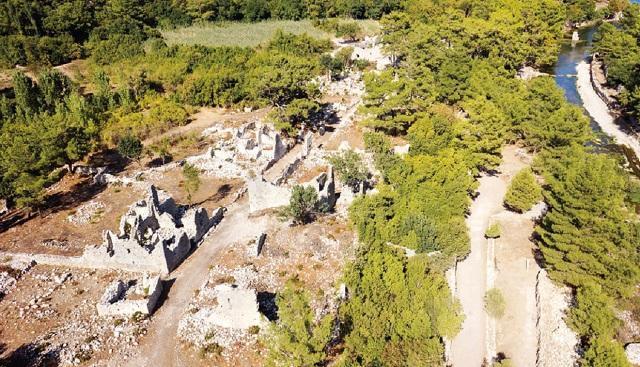
Archaeological excavations in the ancient city of Olympus in the southern province of Antalya’s Kumluca district will start in July in the episcopal palace, which was used as a sacred area in the Roman and Byzantine eras. The works will be carried out simultaneously with the restoration works in the acropolis and necropolis areas.
The head of Olympus excavations, Anadolu University academic Professor Yelda Uçkan said that excavations in Olympus continued for 12 months, adding that the works that had been set to start in March this year could not be started due to the coronavirus outbreak.
“If everything goes well, in mid-July, the latest, we will start our work by taking the necessary precautions against coronavirus. We will have to work with a more simplified team and possibly fewer workers, especially since social distancing protection is in question,” she said.
Stating that they finished 2019 with renovations, Uçkan said that laboratory works have continued since January 2020.
She said that the expert team in Olympus made environmental arrangements in the field, and that they are planning to continue with unfinished repairs in the first phase of this year’s work.
“The valley, where the ancient city of Olympus is located, is surrounded with the slopes of Omurga Mountain in the north direction and the extension of Yolmaca Crest, located in the southeast of the mountain, narrows the mouth of the valley on the sea shore. On this hill with an altitude of 48 meters, there are tower-type houses arranged in two and three floors and a cistern to meet the water need. At the end of last year, we completed the repair of a wall on this acropolis hill, which had a serious danger of demolition. However, the walls on the acropolis hill in general need extensive repair,” she said.
Stating that the works would be adjusted according to the team and worker situation, Uçkan said, “We plan to carry out our excavations in the area that we call the episcopal palace.”
Speaking about this field, which was used as a sacred area in the Roman and Byzantine eras, she said, “There is a sacred area in front of the temple, which belongs to the Roman Imperial Period and where there is a statue dedicated to Emperor Marcus Aureius. We can define this area as a large courtyard. After the Christianization of the city, in this sacred area, which we call ‘temenos,’ Christian buildings were built without touching the temple. The Episcopal Church is located in the area as a central building.”
“There is a baptistery and additional buildings in the north of the church. The church, baptistery, and additional venues form the religious structures of the complex. In the western part of the area, there is peristyl [columnar courtyard] and triclinium [dining-meeting hall] in a natural connection with each other,” she added.
“In the eastern part, there is a bishop residence consisting of places lined up around a courtyard. Apart from these large-scale structures in the area, a large number of venues that seem to have been arranged on two floors were used as the private living rooms of the clergymen and the units where administrative affairs were carried out. Architectural features and finds unearthed in the building complex show us that the complex was used in the 5th and 6th centuries. Last year during excavations here, we found that this area was opened with a door on the road we call the tourist route. This year, we plan to reveal this door,” Uçkan said.
Noting that the episcopal palaces were both religious and administrative centers of the cities during the Byzantine period, Uçkan said, “Here, there were places such as churches and baptisteries, administrative places, and accommodation areas with religious functions. So, we see an example where both private, religious and public spaces are together. For this reason, this palace is important. Another importance is that we see cultural continuity in this area. It is an interesting example that this sanctuary in the Roman period continued to be used as a sanctuary in Christianity.”